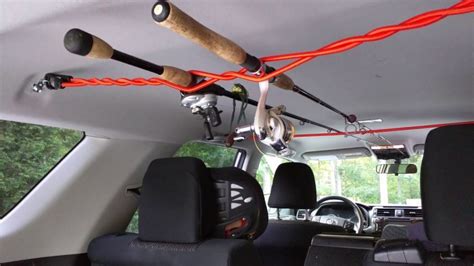How To Transport Fishing Rods
Ronan Farrow
Mar 26, 2025 · 3 min read

Table of Contents
How to Transport Fishing Rods: The Ultimate Guide for Anglers
Transporting your fishing rods safely and efficiently is crucial for any angler. A damaged rod can ruin a fishing trip, so proper transportation is key. This guide provides a comprehensive approach to ensuring your fishing rods arrive at your destination in perfect condition, ready for action.
Protecting Your Investment: Choosing the Right Rod Case
The foundation of safe rod transport is a high-quality rod case. Don't skimp here! Your rods are an investment, and a flimsy case can lead to costly repairs or replacements.
Factors to Consider When Choosing a Rod Case:
- Size and Capacity: Measure your longest rod and ensure the case comfortably accommodates it, with extra space for reels. Consider the number of rods you typically carry.
- Material: Hard-shell cases offer superior protection against impacts. Soft-sided cases are lighter and more portable but offer less protection. Consider your transportation method.
- Padding: Ample padding is essential to prevent rods from rubbing against each other or the case's interior. Look for cases with foam inserts or plush lining.
- Features: Some cases include extra compartments for reels, tackle, and accessories. Consider features that add convenience and organization.
Preparing Your Rods for Transport
Before packing your rods, take these steps to minimize the risk of damage:
Essential Preparation Steps:
- Remove Reels (if possible): This reduces the overall length and weight, making them easier to handle and reduces stress points during transit. If you can’t remove them, secure them firmly to prevent movement.
- Disassemble Multi-Piece Rods: Carefully separate multi-piece rods into their individual sections. This minimizes the risk of breakage during transport.
- Wrap Guides with Protective Material: Consider wrapping the rod guides with bubble wrap or soft cloth to prevent scratching or damage. This is particularly important for more delicate guides.
- Secure Rods Within the Case: Arrange your rods neatly inside the case, ensuring they're not crowded or compressed. Use additional padding as needed.
Transportation Methods and Additional Tips
The way you transport your rods depends on your mode of travel:
Transportation Methods:
- Car: A dedicated rod case in the trunk or secured in the back seat is ideal. Avoid stacking heavy items on top of the case.
- Airplane: Check with your airline regarding size and weight restrictions for carry-on and checked baggage. A hard-shell case is recommended for checked baggage. For carry-on, a shorter, more compact case is often better.
- Boat: Secure rods firmly to prevent them from shifting during travel and ensure they won't be exposed to harsh weather conditions.
Additional Tips for Success:
- Label your Case: Clearly label your case with your name and contact information.
- Regularly Inspect Your Case: Check the condition of your case and its padding periodically to ensure it remains in good shape.
- Invest in Quality Equipment: A high-quality rod case will protect your investment for years to come.
By following these simple yet effective tips, you can ensure your fishing rods are transported safely and arrive at your fishing spot ready for action, preserving the integrity of your equipment and ultimately enhancing your fishing experience. Happy fishing!
Featured Posts
Also read the following articles
| Article Title | Date |
|---|---|
| How To Wear Sock Boots With Jeans | Mar 26, 2025 |
| How To Sublimate On Metal | Mar 26, 2025 |
| How To Soundproof A Dorm Room | Mar 26, 2025 |
| How To Shave Your Legs With A Safety Razor | Mar 26, 2025 |
| How To Tell Rear End Gear Ratio By Vin | Mar 26, 2025 |
Latest Posts
Thank you for visiting our website which covers about How To Transport Fishing Rods . We hope the information provided has been useful to you. Feel free to contact us if you have any questions or need further assistance. See you next time and don't miss to bookmark.
